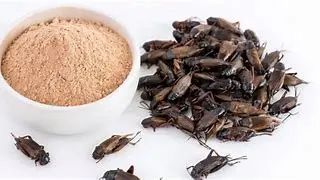Edible Crickets - A New Approach to Protein Energy MalnutritionHite [8] Publish time :2024-09-30
pubilisher:Yuki Chen Aditor:Li Yongmin viewer:Guo Ruiting,Qi Jiaojiao,Zhu Jianfeng
Edible Crickets - A New Approach to Protein Energy Malnutrition
Protein energy malnutrition (PEM) is one of the major public health problems that need to be addressed in developing countries. Livestock products, as an important source of high-quality proteins, are produced with negative impacts such as environmental pollution and climate change. In the face of population explosion and tight supply of traditional proteins, there is an urgent need to explore new and alternative sources of proteins, among which edible insects, especially crickets, are emerging.
The direct consumption of insects or their processing for food has a long history and, according to information, has provided essential nutrition to more than 2 billion people worldwide. Insects such as bees, ants, beetles, as well as crickets and grasshoppers, have a long history of consumption. These insects are not only rich in protein, but also contain a wide range of vitamins, minerals and fatty acids that are beneficial to the human body, providing an important source of nutrition for local populations. As the global demand for sustainable food sources increases, the potential of insects as alternative protein sources is gaining attention.

Nutritional advantages of edible crickets
Edible crickets have a high protein content of 50-60%, with a biological value of 93.02%, a net protein utilization of 75.20%, a net protein ratio of 3.04%, a protein efficiency ratio of 1.78% and a true digestibility of 80.82%.
Recent studies have shown that edible cricket powders (CPs) are not only rich in protein, ranging from 42.0%-45.8%, but also have a sizable fat content of 23.6%-29.1%. In addition, CPs contain moderate amounts of fiber (2.9%-6.4%) and ash (3.6%-4.3%), providing a balanced nutritional composition to the food. In terms of mineral content, per 100 g of cricket flour, the calcium content was as high as 139-218 mg, iron 4.06-5.99 mg, zinc 12.8-21.8 mg, and magnesium, potassium, sodium, copper and manganese all reached significant levels of 86-113 mg, 826-1224 mg, 263-312 mg, 2.33-4.51 mg and 4.1-12.5 mg. These mineral-rich components make CPs ideal additives for new gluten-free food products, not only to enhance the nutritional value of the product, but also to meet the dietary needs of specific populations, such as those with celiac disease.
Given the multiple ecological and environmental advantages that insects offer in terms of sustainability, animal welfare, nutritional value, and global food security, the utilization of insects as a source of protein is growing at an unprecedented rate and is increasingly becoming a focus of attention for food processors and researchers.

Cricket protein in food products
A wide range of cricket protein-based products are now available in the market, providing consumers with attractive options such as protein-rich bakery products and gluten-free breads for celiacs. In addition, cricket protein hydrolysates have been used as preservatives to improve the stability of, for example, cheddar cheese during storage.
In addition, the study revealed the significant potential of full-fat and low-fat cricket flour in the production of fibrous meat substitutes. In the range of 15% to 30% addition, cricket flour can effectively replace some of the soy isolate proteins, which not only enriches the protein composition of the product, but also potentially delivers unique flavor and nutritional value. This discovery opens up new raw material pathways for the meat substitution industry and promotes innovation and development in the industry.
Edible insects are one of the viable solutions to the food security and scarcity problems faced by third world countries and developing nations where animal protein resources are limited or insufficient to meet human dietary needs. As a rich source of proteins, oils, minerals and essential micronutrients, edible insects are expected to be an important way to solve the problem of nutritional deficiencies due to their high efficiency and economy. In the future, as technology continues to advance and consumer awareness improves, edible insects such as crickets will be widely used in more food applications, contributing to global food safety and nutritional health.

